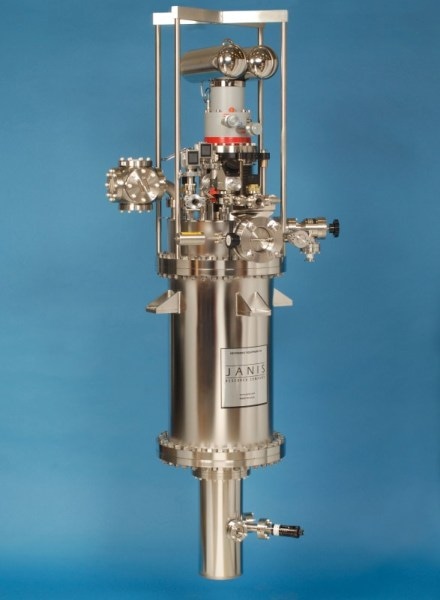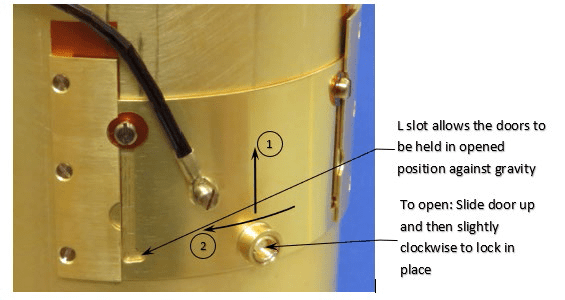Angle-Resolved Photoemission Spectroscopy (ARPES) is used to study the electronic structure of the surface of solids. The ARPES technique employs a synchrotron or laser beam to interact with a sample, resulting in emission of photoelectrons.

By analyzing the energy and momentum of the photoelectrons, the Fermi surface of the material can be mapped. ARPES experiments are often performed in the 2 Kelvin – 10 Kelvin range, but recent research trends often require temperatures below 1 Kelvin (sub-K).
Janis Research delivered the world’s first continuous operating high cooling power “wet” He-3 ARPES cryostat in 2008, achieving a base temperature of 0.9 K. Similar systems have since been installed at leading research facilities around the world, but the recent global helium shortage has made continuous operation of these large sub-K ARPES systems costly. In response to researcher demand, Janis Research has successfully developed another world first, a continuously operating high cooling power cryogen-free (“dry”) sub-K cryostat for ARPES. This dry He-3 system eliminates the need (and cost) of liquid helium, while also simplifying the design and dramatically reducing the cryostat size.
Cryostat design
The Janis Research dry sub-K ARPES cryostat is designed and fabricated for true UHV operation, and can be baked to 90C. A two-stage pulse tube refrigerator (PTR) cools two internal platforms and thermal shields to 35 K (first stage) and 3 K (second stage.) The PTR is mounted by metal sealed CF flange to a z-motion linear translation stage. The PTR is raised and detached from the cryostat during vacuum baking, then lowered into position for normal operation. Heat exchangers mounted to the PTR and platforms precool two independent closed loops of recirculating He-4 and He-3 gas. Two separate He-3 condensers can be used to transform the He-3 gas into liquid; the choice of condenser depends upon experimental requirements and is made by valve adjustment. A He-3 pot is used to collect the condensed liquid, and tapped holes in the He-3 pot are used for sample mounting. Precisely aligned slots in the thermal shields allow the synchrotron radiation or laser to reach the sample. Movable shutters are also installed on the thermal shields and are mechanically linked together. Both shutters can be opened simultaneously for sample mounting and removal using a wobble stick, and then closed to improve thermal performance. A multifunction mechanical heat switch is used to precool the system, and to operate the system in variable temperature (He-4) mode. A large capacity gas sealed roots pump is used to circulate the He-3 gas.

Sliding sample access shutter
Operating principal
The system can be operated in three distinct modes.
He-4 Mode: In this mode, only He-4 gas is circulated; He-3 circulation is not required. After being precooled through the heat exchangers, He-4 gas is condensed through an impedance and enters a 1 K pot. Pumping on the He-4 gas results in a base temperature of ~1.3 K. The mechanical heat switch is configured to provide a direct thermal link between the 1K pot and the He-3 pot, resulting in variable temperature operation in the range of ~4 K – 320 K. This operating mode is especially user friendly, and offers fast thermal cycling of samples over a wide temperature range.
1 K operation mode: In this mode, the mechanical heat switch is opened. External valves are configured to direct the circulating He-3 gas through a heat exchanger inside the 1 K pot. The He-3 gas is precooled and then condensed after expansion through an impedance, collecting inside the He-3 pot and cooling it to 500 mK.
JT operation mode: In this mode, the mechanical heat switch is opened, and the external valves are configured to direct the circulating He-3 gas to the JTCU. The incoming gas is precooled to ~2 K by the He-3 exhaust stream and then condensed by expansion through an impedance, cooling the He-3 pot to 550 mK.
Summary
The Janis Research dry sub-K cryostat for ARPES is a convenient multi-functional tool, suitable for a wide range of research applications. The system offers researchers the means to achieve sub-K temperatures in ARPES configuration, temperatures as low as 300 mK with beam slits closed, as well as high cooling power and unlimited experimental duration.